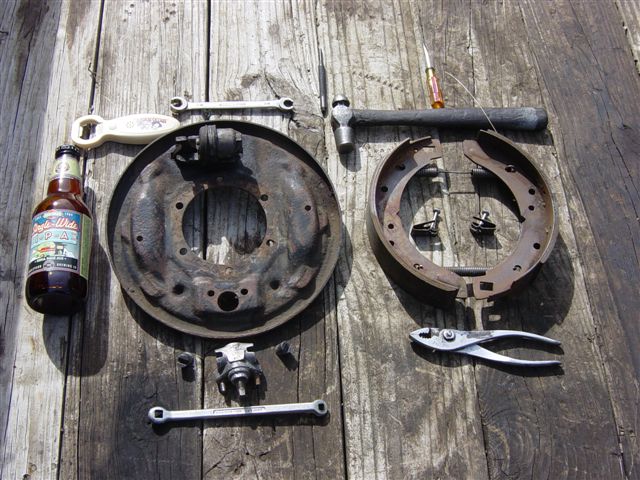What is going on with those pesky brakes? Let’s take them apart starting at the back. While the front brakes do most of the work, it is important that the rear brakes are operating properly. The hand brake really needs to be able to prevent the car from rolling, and should be able to stop the car if the hydraulics fail.
Not too many tools are needed to completely overhaul the rear brakes, and the parts are pretty cheap. A six-pack of beer will be necessary, too. The following description is relevant to Girling systems, which are found on most high end British cars like ours.
Disassembly
2. Remove the wheels. This is a great time to clean them up and check the condition of the studs, and/or wire wheel adapters, which will have to come off, too.
3. Remove the two screws that hold the drum to the hub. You may have to use your impact screwdriver for this job!
4. Back the square head adjuster all the way out. Special wrenches are available, or an eight-sided socket is even better.
5. Remove the drum. The drum should come off easily once the adjuster has been backed off. In the case of terminally frozen brakes, the wheel cylinder, shoe retaining pegs (drill these out), and adjuster mechanism can be released from the back and the drum wrestled off. Avoid hammering on the rim of the drum, as the cast iron chips easily.

6. Remove the clips that hold the shoes to the back plate. Just twist the end of the puny little peg 90 degrees with some pliers and the clip will go flying!
7. Remove the shoes and their springs, noting the position of all the pieces. You should be able to pop each end of the shoes off its perch and pull both off together with the springs still attached.
8. Disassemble the adjuster mechanism and clean and lube the components. It is held on the backing plate with two ¼ bolts, but you don’t really have to take the whole thing off.
9. Disconnect the brake line and hand brake linkage at the wheel cylinder. Cap off the line, or better yet drain the master cylinder reservoir first with your Mighty-Vac. A flare nut wrench should be used on the connection to prevent rounding the nut. Work it back and forth taking care not to twist off the line, which may have rusted to the nut. A little penetrating oil might help.
10. Now the tricky part; remove the wheel cylinder retaining plates by driving them apart with a punch or screwdriver. This is a fiddly job, requiring patience and some strong reading glasses. Swearing is optional. Remove the rubber dust cover and pry the larger plate slightly away from the tabs that keep it in place. Tap the larger plate free. Once that plate is gone, the hand brake lever will slide out past the wheel cylinder and the two smaller plates and cylinder can be removed. Now, sit back with a beer and enjoy the mess you’ve made.
When you’re ready and steady to start putting it back together again, click here.
By Mike McPhail









'Pint Size Project — Rear Brakes — Disassembly' have 2 comments
August 27, 2016 @ 9:36 am Doug Hill
Mike, thanks for this, but you skipped the part about removing the backing plate! It looks like when the bolts are removed it won’t get past the axel.
Is there any way to remove the wheel cylinder while the backing plate is on the car? Not much room in there!
January 9, 2018 @ 6:08 am fernando
I have a tr-3 1956 and I am trying to repair the rear wheel brakes > unfortunately the cylinders are porous and I have not been able to find new ones or refurbished > I live ib colombia south america but i can ship them from any place . thanks